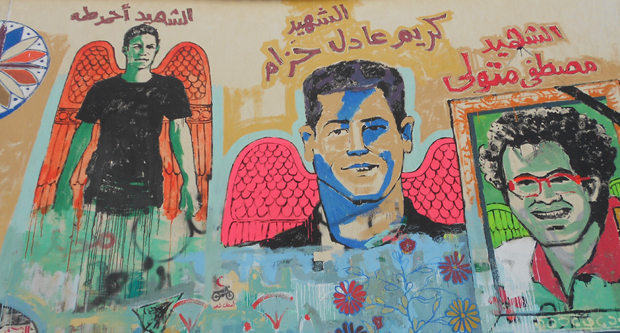Walls of Freedom, a book about the graffiti of the Egyptian revolution, has effectively been banned in Egypt, following the seizure of 400 copies by Egyptian customs earlier this week. The reason? Apparently the book “instigates revoltâ€. Read the foreword of the book Egyptians aren’t allowed to see, by AHDAF SOUEIF.Â
The streets mattered. They were where we lived, met and talked; where we renewed our commitment to our ideas and to each other. In the streets we were at our strongest and our most vulnerable; it was in the streets that many of us were wounded, kidnapped, beaten – that some of us died. But in the streets we were together; each one of us was out there doing everything we could to push the revolution forward, and to reaffirm also – to re-experience – the certainty we carried in our hearts: I am not alone. I am one small part of something amazing, of a massive movement of humanity with a common will towards the good.
And when the street art of the revolution appeared it reconfirmed that certainty a million-fold. For it did what only art can do: art shows you your own feelings, your own thoughts and impulses, articulated, transmuted, given form. And it shows you, in that act of mutual recognition, that you and the collective are one.
The streets of the revolution were our world; and the street art of the revolution expressed and celebrated our world. It blossomed on the walls; speaking for us and to us, a miraculous manifestation of the creative energy the revolution had released across the country.
It started small: stencils of Khaled Said, killed by Mubarak’s thuggish police in Alexandria in 2010, then the stencil of Mina Danial killed by the army in Maspero in October 2011. Then there was the amazing moment when Mina Danial appeared in freehand, sitting cross-legged at the base of a pillar, with brilliant giant multi-coloured angel-wings bursting from his back. Soon he was joined by Sheikh Emad Effat, angel wings rising from his back too, and Quranic verses flowing from his outstretched hand. And across the road from Mina and Emad black angels in gas-maks rose from the pavement to hover on the wall of the American University.
The artists who call Egypt home have put themselves in the heart of the revolution. One of our earliest martyrs was Ziyad Bakeer, known for his brilliant set designs for the Opera House. Ganzeer’s graffiti punctuated our vistas. I saw a Sad Panda slouching under a fly-over at the outmost tip of Cairo in Maadi. Mosireen’s footage, appropriated by the youth of the revolution, screened on thousands of walls the length and breadth of Egypt. Poetry and music marked and accompanied all our actions. Ammar and his friends came up from Luxor and joined the Cairo artists, and when – in an explosion of brutality – the army and police killed 42 people and injured more than 3,000 on Muhammad Mahmoud Street in November 2011 – it was these artists who answered with their own explosion on the walls of the street: the miraculous giant murals with their mix of pharaonic, Coptic, Islamic and modern art. The blood of the martyrs had consecrated Muhammad Mahmoud as a place of pilgrimage, the murals made it a pilgrimage of both mourning and celebration, of renewal.
Our street art exemplified the difference between the revolution and the system: the system murdered, the revolution immortalised. The system used teargas and live ammunition, the revolution used stones and drums and fireworks. The system built brutal, obstructive walls partitioning the streets of downtown, the revolution transformed these walls into rainbows, tropical beaches, and playful trompe l’oeil vistas of the streets themselves.
In the streets of the revolution we talked a lot about how the people were ahead of the political classes, ahead of academia and the theoriticians. The people were leading the way. But we needed the political scientists, the academics to catch up; the revolution needed them to describe it, to theorise it, to map it.
This book is an attempt to do that; part witness, part theory, part commemoration, it is an act within our revolution – our continuing revolution.

– This article was originally published at the foreword of Walls of Freedom. Soueif subsequently published it on Facebook. All links have been added by The Daily Vox Team.
– Featured image. Graffiti on Muhammad Mahmoud Street, downtown Cairo, early 2012. By Theresa Mallinson.









